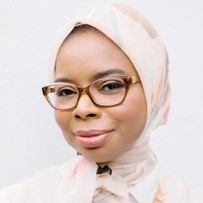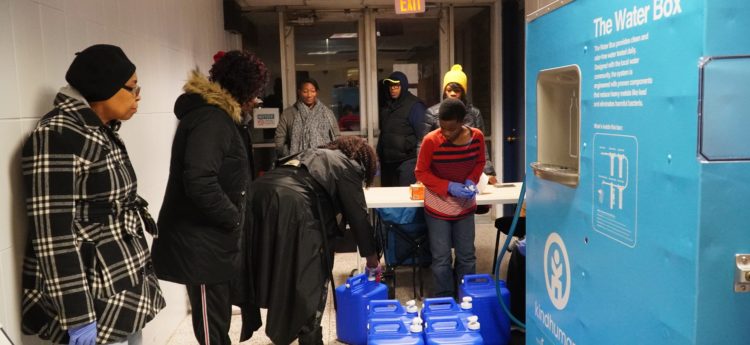
Maryum Rasool, Executive Director, Sylvester Broome Empowerment Village (SBEV)
Taking a ‘village’ approach to Flint’s future
by Kathleen Pierce
Flint, Michigan, is more than a water crisis. It’s a community. While the nation’s attention may have shifted away from the tragedy and injustices of its water struggles, community leaders aren’t giving up on the city or its kids. Case in point: the Sylvester Broome Empowerment Village (SBEV), which emerged from the darkest days of the water crisis to create a thriving space to empower students and revitalize Flint. In this installment of Community Insights, we look beyond the headlines for a glimpse of a community working toward a better future.
In 2019, SBEV turned to Thriving Earth Exchange for help collaborating with scientific partners to design a green roof for SBEV’s 62,000 square foot, 100-year-old building. It soon became clear that SBEV had a lot going on under that roof.
We spoke with Maryum Rasool, a longtime Flint resident who served on the board of SBEV before becoming its Executive Director in 2017. She has seen SBEV grow from just 30 kids in its afterschool program to almost 700 today, and helped it flourish into a community hub that can reach more than 7,000 families at larger events. The programs SBEV offers students—music production, sports, tutoring, performing arts, health and wellness, art, science and technology, and media studies—are all free of charge and centered around real community needs.
- How would you describe SBEV?
Rasool: SBEV was established at the end of 2015. Initially, the water crisis was at the forefront of the community, and we were able to create a space where the community could come and get fresh water, free dermatology consultations and free lead testing.
In June of 2017, the water hub ended and our focus was providing supportive services to the community, primarily the youth, because we realized we needed to support lead-affected children, who were now entering schools.
- How was the SBEV community able to grow so quickly, and what makes it unique?
Rasool: We were able to expand so quickly with little-to-no funding and serve so many families because we took the “village” approach, partnering with programs that already had funding but needed a home or access to children. That model really allowed us to operate at full capacity without worrying about staff, supplies or grant writing. We’re a small town and we all rely on some of the same foundations. [The attitude was] if we’re trying to serve the same community, let’s pull together and stretch these resources.
I think that’s the biggest takeaway — you don’t have to do it alone, you don’t have to recreate the wheel. We have to come together, especially in these times, no matter how different we look from one another, no matter how different our cultures are. The bottom line is that we have to help one another so that we can all win. I really believe in that and that’s how we were able to have such success in such a small amount of time, because of our community partners and because the community was able to step in and assist us with our mission.
- What do you see as unique strengths of SBEV and the community it serves?
Rasool: When I first came, one of the first things we did was rent an ice cream truck and drive around giving out free ice cream and a survey to identify what the needs are in the community. We wanted it straight from the horse’s mouth—what they needed, and what they would take advantage of. You can’t tell people what they need, people need to tell you, and that’s what we built our programming around. We still have community forums and family interactions to evolve and adjust our programming as needed.
We also use the Youth Engagement Hours (YEH) model, which shows a correlation between the amount of time spent on our campus versus an increase in school grades, reading level, attendance and behavior. We create a space where students can excel on an individual level, and the YEH data helps to fine-tune the programs that we offer.
- What do you see as its unique challenges or struggles?
Rasool: The challenge with Flint students currently is that only 10% are at reading grade level, and these kids haven’t been given the right tools. Obviously the water crisis is ongoing, and we still provide water to the community, but the outcomes of the lead effects are ever-changing and ever-evolving, and the learning challenges are there. Our kids are extremely smart, extremely talented, and if given the right tools they will have a bright, bright future.
- What do you think people would be surprised to learn about your community?
Rasool: We do focus on fun, but at the end of the day you can have fun in a learning environment and walk away with a skill set. So every program that we have, you’re getting a skill set, you’re progressing, so that by the time you finish high school you have skills. Our music production program is modeled on the local community college’s, to give kids a head start if they want to do that. We also connect them with college scholarships.
- What do you hope your community will be like in 20 years?
Rasool: Twenty years from now, the goal is to have a vibrant, revitalized corridor, and families would come back to Flint. Next year, we’re building an indoor sports complex with a football field and basketball courts. It’s part of a step to bringing sports back to Flint schools. Flint is known per capita for having the most professional athletes come out of our city, and we’re trying to bring that back. And that would help revitalize Flint schools, which in the 1960s were one of the best school systems in America. We can get there again.
Kathleen Pierce is a freelance writer with Creative Science Writing.

